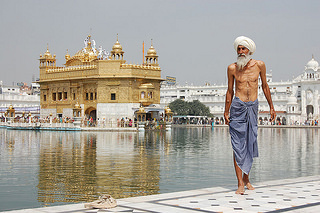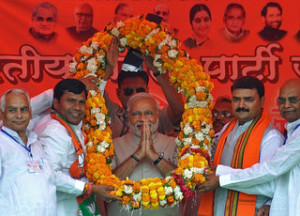Behind Indian Soft Power
 Via Flickr
Via Flickr

In less than three months, the resolution for an “International Day of Yoga” on June 21, spearheaded by India’s Foreign Office, was unanimously passed at the United Nations General Assembly.[1] Yoga’s growing international popularity is part of Prime Minister Narenda Modi‘s soft power strategy that insist “yoga is about harmony between man and nature; a holistic approach to health and welling …[and can even] help us deal with climate change.”[2] In Modi’s premiership, he has held high-profile bilateral visits and attended multilateral forums with the world’s major powers such as China, Japan, United States, BRICS, G-20 and more.[3] During Australian Prime Minister Tony Abbot’s recent visit to India, he claimed, “India threatens no one.”[4] While Modi’s efforts succeed in painting India as paradise of enlightened white-bearded vegetarian yogis and cheerful Bollywood dancers, the country’s grim internal politics, grave violation of human rights and increasing economic influence receive far less attention from the international audience.
Despite the fact that yoga is generally perceived to be a peaceful lifestyle by the West, India’s most marginalized religious groups see it as a suspicious Hindu religious ritual.[5] In Muslim-majority regions such as Kashmir, Uttar Pradesh, Maharashtra, Bengal and Bihar, Modi’s Hindu Nationalist Bharatiya Janata Party is regarded as a threat, reminder of injustices suffered under Hindu rule and a step closer towards Hindu fundamentalism.[6] Though Modi’s soft power strategy promotes India as a model state for developing countries to pursue democracy as a mean for development, the legitimacy of the world’s largest electoral democracy is often questioned. First, only 32% endorsed the BJP in the popular vote in 2014, meaning a vast majority of India did not.[7] This is unsettling for a country that had experienced two major ethno-religious separatist movements and consistent oppositions from the Muslim communities. In fact, Modi is a member of the Rashtriya Swayamsevak Sangh (RSS), a nationalist organization that is inspired by fascist movements in Nazi Germany and behind the Gujarat Massacre in 2002.[8] Therefore, contrary to its friendly international reputation, Modi’s government is believed to be a xenophobic one, especially by the most oppressed religious groups.
Furthermore, with 43% of Indian children under five undernourished, a present caste system that reinforces social hierarchies, extreme poverty, illegal and exploited labor, gender discrimination and gang rapes, India has reached alarming levels of human rights violations. Recently, prominent film director Padma Vibushan criticized the democratic government for imposing censorship on cuss and ludicrous words, and adopting practices like China.[9] Albeit Modi attempts to reinvent himself as the messiah of development and freedom, human rights violations, the country’s social welfare problem and setbacks in the freedom of speech create huge disparities between what the Modi government promised and the reality.
India’s is transitioning from an aid recipient country to one of today’s largest donor countries, and spreading economic influence especially in regions of Central Asia and Africa. For instance, India has invested more than $2billion in Afghanistan to help rebuild institutions and infrastructure.[10] Moreover, it has partnered with Iran to construct the Chabahar port to connect Central Asia. As the second largest importer of Iranian oil, India has poured millions of dollars to build an Iran-Oman-India Gas pipe. [11] India’s economic activities in these regions allow it to gain significant bargaining power in Central Asian politics. If Indian involvement in the respective areas continues to grow, it may be influential enough to contend Chinese influence and interest.
It is also paradoxical that the world’s most “peaceful” country is the only nuclear power that is a non-signatory to the Non-Proliferation Treaty. [12] While the BJP was in power 1974 and 1998, India has frequently tested its nuclear weapons and claim that the bomb was the last resort in a world of threatening nuclear states that make no pledges to refrain from first strikes and the use of nuclear states, and bargaining chip to support disarmament.[13] This is rather oxymoronic to use nukes for disarmament. Regardless of its intentions with harbor nuclear weapons, it is uncommon to associate India with nuclear weapons. In essence, it is incorrect to simply label India as country that poses no threat and put it on the sideline of international politics. There is more to Modi’s soft power strategy than yoga and Bollywood. With Modi’s active government, increasing wealth, investments in foreign countries and nuclear power status, India is becoming a greater player in the world and must be recognized as one.
[1] Mohan, C. Raja. “Modi’s Diplomacy: Yoga, Democracy, and India’s Soft Power.” Carnegie Endowment for International Peace. December 15, 2014. Accessed April 1, 2015. http://carnegieendowment.org/2014/12/15/modi-s-diplomacy-yoga-democracy-and-india-s-soft-power.
_______________________________________________
[2] Ibid.
[3] Martin, Peter. “Yoga Diplomacy.” Global. January 15, 2015. Accessed April 1, 2015. http://www.foreignaffairs.com/articles/142812/peter-martin/yoga-diplomacy.
[4] Pethiyagoda, Kadira. “India’s Soft Power Advantage.” The Diplomat. September 17, 2014. Accessed April 1, 2015. http://thediplomat.com/2014/09/indias-soft-power-advantage/.
[5] Mohan, “Modis Diplomacy Yoga Democracy and India’s Softpower.”
[6] A. Delvoie, Louis. “India: Rise of Hindu Nationalism.” The Kingston Whig-Standard. March 6, 2015. Accessed April 1, 2015. http://www.thewhig.com/2015/03/06/india-rise-of-hindu-nationalism.
[7] Ibid.
[8] Mishra, Pankaj. “Narendra Modi and the New Face of India.” The Guardian. May 16, 2014. Accessed April 1, 2015. http://www.theguardian.com/books/2014/may/16/what-next-india-pankaj-mishra.
[9] Das, Gaurav. “Censorship Has No Place in a Democracy: Adoor – The Times of India.” The Times of India. March 31, 2015. Accessed April 1, 2015. http://timesofindia.indiatimes.com/city/guwahati/Censorship-has-no-place-in-a-democracy-Adoor/articleshow/46749561.cms.
[10] How india is using soft energy interest
[11] D. Mullen, Rani, and Sumit Ganguly. “The Rise of India’s Soft Power.” Foreign Policy The Rise of Indias Soft Power Comments. May 8, 2012. Accessed April 1, 2015. http://foreignpolicy.com/2012/05/08/the-rise-of-indias-soft-power/.
[12] Pethiyagoda, Kadira. “India’s Soft Power Advantage.” The Diplomat. September 17, 2014. Accessed April 1, 2015. http://thediplomat.com/2014/09/indias-soft-power-advantage/.
[13] Pethiyagoda, Kadira. “India’s Soft Power Advantage.” The Diplomat. September 17, 2014. Accessed April 1, 2015. http://thediplomat.com/2014/09/indias-soft-power-advantage/.
